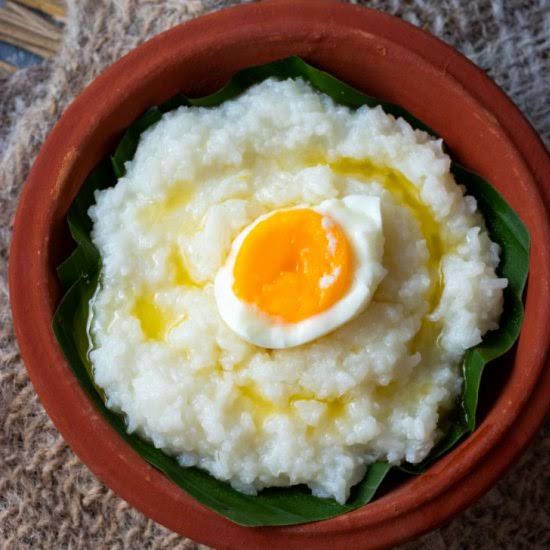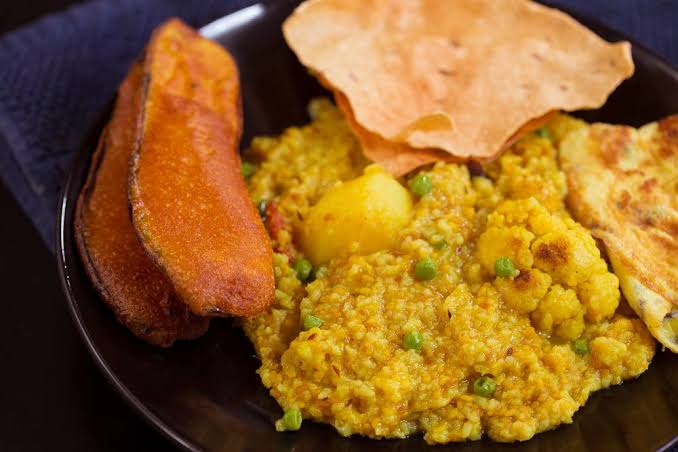It’s that time of the year again, when the entire city awakens from its “lyad” to enthusiastically celebrate the homecoming of Goddess Durga. And of course, good food is a crucial component of the agenda. Every year since 2019, I’ve posted a series of special articles during Pujo, ranging from solo write-ups to collabs to amazingly penned guest articles.
This year has been rough for my blog, with me being rather hard-pressed for time to write anything substantial. But it would be criminal to let this festive season go by without atleast one write-up, even if it’s hastily put together 1200 miles away from home.
A Bengali’s love for rice manifests in a variety of forms, from the panacea of khichuri during the times when they’re e feeling under the weather, to the glorious celebration with biryani everytime India wins a match or when semesters end or when it’s a Wednesday……we don’t need an excuse do we? There are two Bengali rice dishes that follow a similar overall formula, but certain crucial differences create two very different end-results. This time, let us explore the polao and the ghee bhaat, ideal staples in any celebratory meal, the trusty sidekick to the kosha mangsho and mangsher jhol we’ve talked about in the past years.

Mishti polao, often called basanti polao, is made with gobindobhog rice and stained yellow with turmeric. The only flavourings to speak of are ginger, whole green chillies, and a tempering with the usual trio of elach (cardamom), lobongo (clove), darchini (cinnamon). Ghee bhaat on the other hand, is a cross between a Chinese fried rice and a basanti polao. It uses long grained basmati rice instead of gobindobhog, untainted by the yellow smear of turmeric. The rice isn’t pristine white however, owing to the last-minute addition of a subtle mixture of spices which makes it a touch more savoury than the basanti polao.

The choice of rice is the first point of departure, and it makes for a rather important difference. Gobindobhog is a short-grained, starchy, aromatic rice that is prized by Bengalis as much as the Italians prize their carnaroli and arborio. Plain gobindobhog rice with some ghee and mashed potato or boiled egg is peak comfort food; the subtle nutty aroma of the rice enhancing the experience even further. Basmati is yet another aromatic rice usually more liberally outside Bengal. The long grains of Basmati stand out nice and fluffy when cooked well, and it’s unique aroma elevates any dish, from ghee bhaat to biryani.

What gives the ghee bhaat its visual appeal is the array of vegetables that adorn it. While both basanti polao and ghee bhaat have fried cashews and raisins added to them, the latter also celebrates the bounty of winter vegetables: an abundance of peas, carrot, and french beans. Granted, I’ve always found the rice to veggie ratio of the biyebari versions to be unfairly out of balance, but my mother’s home-cooked version always had a lot of veggies. After all, it is a great way to get children to eat vegetables so the more, the merrier.

Both dishes start off by toasting the washed rice and the dried fruits in ghee tempered with whole spices. In the case of ghee bhaat, the veggies go in along with the rice. In the case of the basanti polao, you could actually mix the rice with ghee, ground ginger and turmeric before adding it directly to the pan. Care must be taken to wash the rice very, very thoroughly, especially in case of the starchy gobindobhog. Unlike a khichuri or payesh, where the end result is creamy, a well-made basanti polao must be fluffy and non-clumpy, which requires washing off all of that extra starch.

After the rice is sufficiently toasted, just the right quantity of water is added to cook the grains through without making the dish too mushy. When done, in goes the sugar: extra-generous in case of the basanti polao, reined in by the heat of a few slit green chilies which go in at the same time. This excess of sugar in traditional rice dishes, be it basanti polao or ghee bhaat, is a typically Bengali trait. The South Indian style palav is a lot more savoury, with an abundance of veggies which makes it more akin to ghee bhaat than Bengali polao. For the ghee bhaat, the final flavour mix is a bit more nuanced, comprising sugar, black salt, black pepper and garam masala. Both dishes, of course, are finished with a mandatory dollop of ghee.

Ghee bhaat is often called sada polao or Bengali style fried rice on menus, and it is with the latter, cross-cultural nomenclature that I have grown up. While it looks quite a bit like fried rice and is bejeweled with an array of colourful veggies like any classic Chinese fried rice, the Chinese dish is a matter of convenience, using up leftover rice by mixing it up with bits and pieces of other stuff to make a complete, hearty meal. Ghee bhaat on the other hand, is very emphatically a celebratory dish, so there is no way that we are using leftover rice.

The dish is made by cooking the vegetables, adding the rice and seasoning and stirring in a kadhai over a low flame till the flavours meld. Ghee bhaat or Bengali “fried rice” is much more subtle in its flavours compared to its Chinese counterpart. It is also a lot sweeter than Chinese fried rice, or even Indo-Chinese fried rice for that matter, with a significantly large amount of sugar. A fried rice is punchier, aromatic with ginger and garlic, with that slight char on the rice grains and an umami upgradation thanks to the sprinkle of MSG.

The difference in the end-products is well-reflected in the way of cooking: a Chinese stir-fry is all about being fast and furious. The rice, veggies, proteins and sauces are furiously tossed together in a wok over a searing flame which cooks it in minutes and imparts the rice with “wok hae”, a characteristic smoky note often described as the breath of the wok. It is very far off from the gentle labour of love that is the ghee bhaat, resulting in a dish that is mellower, less assertive in its flavours, the ideal second fiddle to the rich dishes that are served alongside.

While the sweetness of a basanti polao makes it ideal for a super-rich kosha mangsho, all savoury from the Maillard reaction and tan from the slow caramelisation, ghee bhaat, with its balance between sweet and savoury, is possibly a bit more suited for a lighter mangsher jhol, a rich fish kaalia, or any number of chicken dishes. Ghee bhaat also pairs excellently with more elaborate vegetarian dishes like an exceptionally indulgent dhokar dalna or a sumptuous phulkopir roast.
There is no way that rice is left out of our celebrations. While the Kolkata biryani is a Mughlai import and better dealt with by the professionals, basanti polao and ghee bhaat are a home-cooked labour of love, perfectly encapsulating the Bengali principle of minimalism, elevating a handful of ingredients to pure ambrosia.
Wishing all readers of The Gourmet Glutton a very happy Durga Pujo!